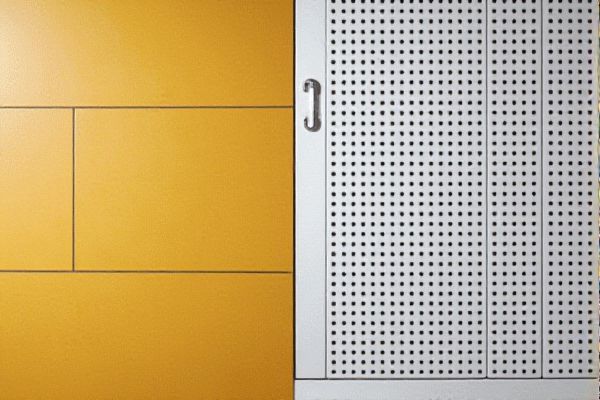
Perforated pegboard offers better ventilation and easier customization for tool organization, while solid pegboard provides a sturdier surface ideal for heavy or specialized equipment. Explore the rest of the article to determine which pegboard best suits your workspace needs.
Table of Comparison
| Feature | Perforated Pegboard | Solid Pegboard |
|---|---|---|
| Material | Wood, metal, or MDF with multiple holes | Wood or MDF without holes |
| Purpose | Tool organization using hooks & accessories | Decorative backing or mounting surface |
| Customization | Highly customizable with various hole patterns | Limited customization; may require drilling |
| Load Capacity | Supports light to medium weight items | Can support heavier loads if properly mounted |
| Installation | Easy to install and reorganize | Requires more effort to modify or mount items |
| Applications | Workshops, garages, retail displays | Wall paneling, furniture backing, decorative uses |
| Cost | Typically lower cost due to simple manufacturing | May cost more depending on material and finish |
| Visual Appearance | Industrial or utilitarian look | Sleek and solid surface appearance |
Introduction to Pegboards: Perforated vs Solid
Perforated pegboards feature evenly spaced holes that allow for flexible tool organization with hooks and accessories, making them ideal for customizable storage. Solid pegboards offer a continuous flat surface best suited for mounting shelves or magnetic strips, providing sturdy support for heavier items. Your choice depends on whether you need adaptable hanging options or a solid base for fixed storage solutions.
Material Comparison: Perforated and Solid Pegboards
Perforated pegboards are typically made from materials like wood fiber, metal, or plastic, featuring evenly spaced holes that allow for flexible tool and accessory placement, while solid pegboards lack these holes and are often constructed from solid wood or MDF, offering a sturdier but less versatile surface. The perforated design enhances air circulation and visibility, making it ideal for workshop organization, whereas solid pegboards provide a smooth surface better suited for mounting shelves or heavy-duty hooks. Choosing between perforated and solid pegboards depends on your need for adaptability versus strength in your storage solutions.
Installation Process: Ease and Requirements
Perforated pegboards are easier to install due to their lightweight design and pre-drilled holes that allow for quick mounting on various wall types with minimal tools. Solid pegboards require additional drilling or modifications to accommodate hooks, increasing installation time and complexity. Choosing perforated pegboards reduces the need for specialized equipment, making them ideal for DIY projects and efficient setup.
Durability and Longevity of Each Type
Perforated pegboards, typically made from metal or high-density fiberboard (HDF), offer enhanced durability due to their resistance to warping and moisture damage, making them ideal for heavy-duty tool storage in garages and workshops. Solid pegboards, often crafted from wood or MDF, provide good longevity in dry, indoor environments but may deteriorate faster when exposed to humidity or heavy loads. Choosing perforated pegboards ensures longer-lasting performance and structural integrity in demanding settings, while solid pegboards suit lighter, controlled applications.
Weight Capacity and Load Support
Perforated pegboards offer superior weight capacity and load support due to their metal construction and evenly spaced holes designed for heavy-duty hooks and accessories, making them ideal for organizing tools and equipment. Solid pegboards, typically made of MDF or hardboard, provide moderate load support but are less durable under heavy weights, often restricting the size and weight of items hung. Choosing perforated pegboards enhances structural stability and maximizes storage potential, especially in industrial and garage settings where heavy tool storage is crucial.
Customization and Accessory Compatibility
Perforated pegboards offer superior customization and accessory compatibility by featuring evenly spaced holes that accommodate various hooks, bins, and shelves, allowing flexible tool and item arrangement. Solid pegboards, lacking pre-drilled holes, require additional modifications such as drilling to attach accessories, limiting quick reconfiguration options. This inherent design difference makes perforated pegboards more efficient for adaptable storage solutions and frequent layout changes.
Aesthetics and Design Considerations
Perforated pegboards offer a modern, industrial aesthetic with visible holes that create texture and allow customization through hooks and accessories, making them ideal for flexible, dynamic designs. Solid pegboards provide a clean, minimalist look with a smooth surface that can be painted or finished to match your interior style, making them perfect for seamless, contemporary spaces. Your choice depends on whether you prioritize functionality with a rugged design or a sleek, uniform appearance.
Cost Analysis: Perforated vs Solid Pegboards
Perforated pegboards typically cost more per square foot than solid pegboards due to the manufacturing process involving precise hole punching for tool organization. Solid pegboards offer a lower initial investment, but they lack built-in functionality, often requiring additional accessories that can increase overall expenses. Evaluating total project costs should include installation complexity, accessory compatibility, and customization needs between perforated and solid pegboard options.
Best Use Cases for Each Pegboard Type
Perforated pegboards are ideal for organizing tools and supplies in workshops, garages, and retail displays, offering versatility with hooks and attachments that fit evenly spaced holes. Solid pegboards provide a sturdy surface for mounting heavier equipment or decorative panels, suitable for areas requiring durable backing without visible holes. Choosing between the two depends on whether accessibility and customization or structural integrity and aesthetics are prioritized in the workspace or display area.
Conclusion: Choosing the Right Pegboard for Your Needs
Perforated pegboards offer versatile organization with customizable hooks and accessories, making them ideal for tool storage and display. Solid pegboards provide a sleek, durable surface suitable for mounting heavier items or creating a seamless look in workshops or retail spaces. Selecting the right pegboard depends on weight capacity requirements, flexibility in layout, and aesthetic preferences tailored to your specific workspace needs.
 homyna.com
homyna.com